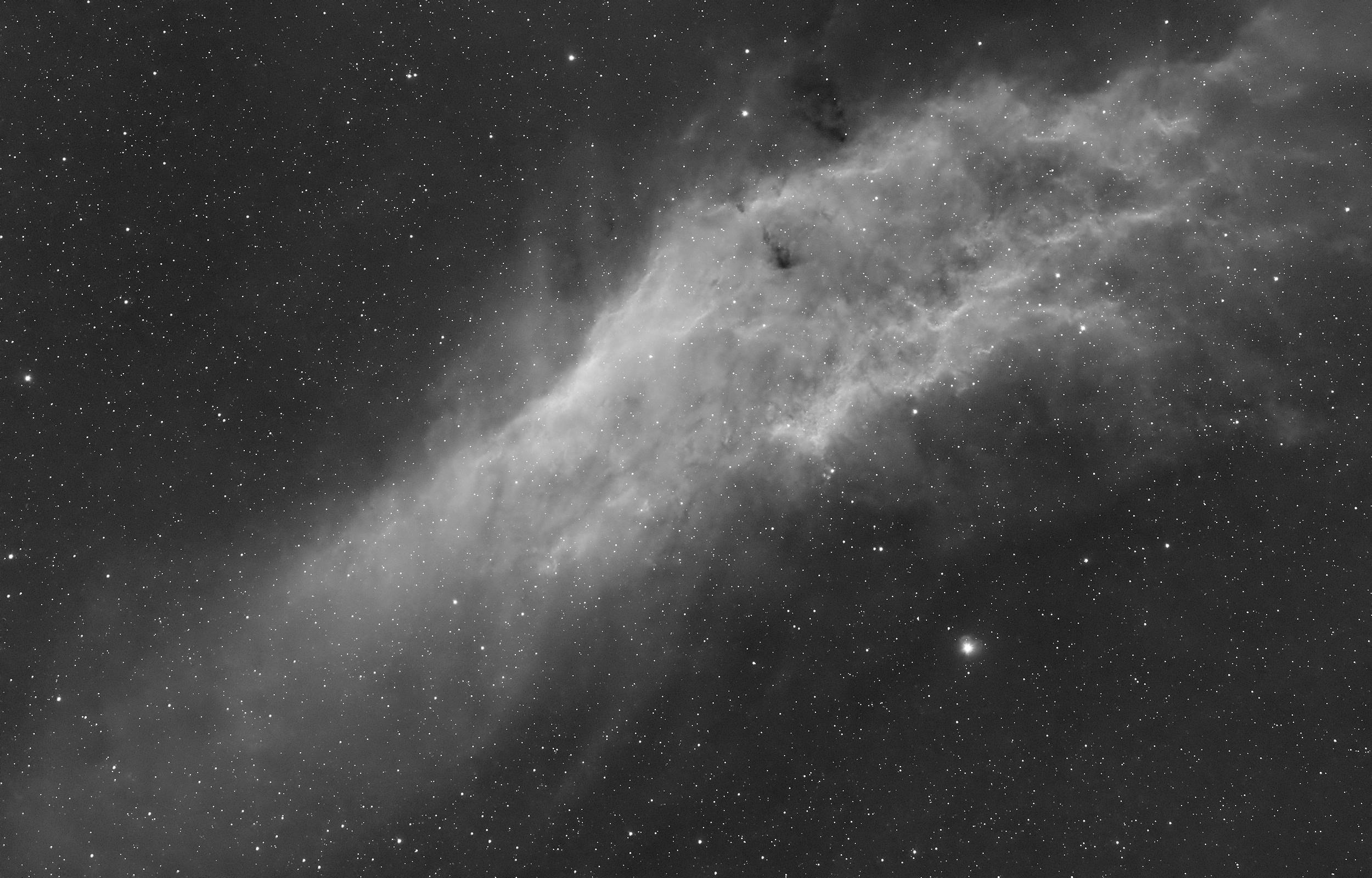The Night Sky - Episode 11
THE CALIFORNIA NEBULA
This is episode 11 in my series on our night sky.
Astrophotography has the incredible ability to unveil the wonders of the cosmos, allowing us to witness celestial phenomena otherwise hidden from the naked eye. One such captivating night sky object is the California Nebula, officially designated NGC 1499.
An image of the California Nebula (NGC 1499). Over 8.5 hours of faint light from deep space were captured to create this image.
Image by Achint Thomas
The California Nebula (NGC 1499) is an emission nebula located in the constellation Perseus. Spanning an impressive area of approximately 100 light-years, this celestial masterpiece dazzles with its distinctive red glow. From our vantage point here on Earth, the nebula covers an area of about 2.5 arc-degrees in the night sky. This is about 5 times as wide as the full moon, an impressive expanse! The nebula is situated at a distance of approximately 1,500 light-years from Earth. This vast celestial formation is located within the Orion Arm of the Milky Way galaxy. Our own solar system is also located within the Orion Arm, making NGC 1499 a rather close neighbour to us.
The California Nebula derives its common name from the striking resemblance of its shape to the US state of California, with its western boundaries resembling the state’s coastline.
Emission Nebulae: Cosmic Birthplaces of Stars
Emission nebulae, like the California Nebula, are among the most captivating regions of our cosmos. These celestial wonders are composed of ionized gases which emit light when their atoms are excited by the intense radiation of nearby stars and are often characterized by their vibrant, glowing colours.
The striking red hue of the California Nebula, for instance, arises from the energetic radiation of the nearby star Menkib (also known as ξ Persei), which ionizes the surrounding hydrogen gas, causing it to emit light in the red wavelengths. The colossal radiation and stellar winds from Menkib shape the nebula's form and structure.
Emission nebulae are not only visually stunning but also hold the key to understanding the mechanisms of star formation, the interstellar medium, and the complex dynamics at play in the cosmos. Within the depths of these nebulae, a wondrous cycle unfolds. The massive stars responsible for the ionization are, in fact, often born from the very material they now illuminate. As gravitational forces cause regions of the nebula to collapse, dense pockets of gas and dust form. Over time, these pockets grow increasingly compact and hot, eventually reaching the critical temperature and pressure needed for nuclear fusion. It is at this juncture that stars are born, blazing forth with brilliant luminosity. These nascent stars continue to shape their environment as their intense radiation begins the ionization process, further illuminating the nebula and perpetuating the cycle.
Menkib: NGC 1499’s Luminous Neighbour
Among the cosmic surroundings of the California Nebula (NGC 1499), a star of notable significance stands out - Menkib, officially designated as ξ Persei (or Xi Persei). This massive star commands attention not only for its proximity to the nebula but also for its remarkable characteristics that contribute to NGC 1499's spectacular display.
Menkib (ξ Persei), an O-type blue giant star responsible for the formation of the California Nebula.
Image by Achint Thomas
Menkib is a stellar blue giant classified as an O-type star. These stars are among the most luminous, massive, and hottest in our universe. With a surface temperature of around 35,000 degrees Celsius, Menkib blazes with a fierce blue-white hue, standing as a stark contrast to the California Nebula's fiery red magnificence. In comparison, our sun has a surface temperature of only about 5,500 degrees Celsius. Furthermore, Menkib - while massive - is a very young star in cosmic timescales at only 7 million years old. And it is projected to survive for only another million years, or so, making it a very short-lived star.
Positioned at a distance of approximately 1,800 light-years from Earth, Menkib occupies a pivotal location in the vicinity of NGC 1499. Its intense ultraviolet radiation permeates the surrounding gas and dust, serving as the primary source of ionization that gives rise to the nebula's radiant red glow. The brightness of the star is such that it significantly influences the visual appearance and structure of the California Nebula, casting its vivid signature upon the surrounding hydrogen gas.
Menkib's presence near the California Nebula, although visually captivating, also provides astronomers with an invaluable opportunity to investigate the dynamic relationship between massive stars and the nebular material that envelops them. The star's gigantic size and intense radiation exert a profound influence on the surrounding cosmic landscape, shaping the nebula's structure and contributing to the complex processes of ionization and star formation within.
Perseus Constellation: Home to the California Nebula
The California Nebula resides in the constellation Perseus, a constellation steeped in Greek mythology. This constellation is known for its associations with the hero Perseus, who was famous for his daring feats, including the slaying of Medusa.
Location of the Perseus constellation in the night sky.
Image by Achint Thomas
The nebula is also situated close to the Pleiades Cluster (a.k.a the Seven Sisters). This open star cluster, located in the constellation Taurus and containing dozens of young stars, is one of the most iconic and easily recognizable star clusters in the night sky.
Read more about the Pleiades Cluster in my episode on this fascinating star cluster which has been named by many ancient civilizations.
The California Nebula (NGC 1499) is located near Perseus’ “knee”. The star at the knee is Menkib (ξ Persei). The Pleiades Cluster (M 45) is also visible in close proximity.
Image by Achint Thomas
The California Nebula's proximity to the Pleiades Cluster provides a stunning juxtaposition between a young, star-forming region and a cluster of relatively young stars. Observing these celestial entities side by side offers a fascinating opportunity to study different phases of stellar evolution and witness the cosmic cycle in action.
H-alpha Imaging: Unveiling the Beauty of Emission Nebulae
To capture the mesmerizing beauty of the California Nebula, astrophotographers often employ specialized imaging techniques. One such technique is Hα imaging.
Emission nebulae like the California Nebula are especially rich in hydrogen gas, and they emit light at a specific wavelength (656.46 nm) in the red part of the spectrum, known as the hydrogen-alpha (Hα) line. Hα imaging focuses on capturing this particular wavelength, enhancing the contrast and bringing out the intricate structures and details of the nebula.
Hα imaging typically involves using specialized filters that isolate the Hα wavelength, allowing astrophotographers to capture images that highlight the emission nebula's glowing regions. This technique not only emphasizes the nebula's beauty but also provides critical information for scientific research. By examining the intensity and distribution of Hα emissions, astronomers can gain insights into the physical properties of the nebula, such as its density, temperature, and the presence of ionization fronts.
Hα image of the California Nebula.
Specialized filters are used to capture a small band of wavelengths corresponding to the hydrogen-alpha emission line. This image is then combined with a full-colour image of the same region to render the correct colours. This technique helps boost the contrast of the nebula against the sky by cutting out light pollution.
Image by Achint Thomas
Furthermore, Hα imaging helps reveal the complex network of dark dust lanes and filaments that thread their way through the nebula, shaping its structure and contributing to its visual appeal. These detailed images serve not only to capture the aesthetic qualities of the California Nebula but also to further our understanding of the processes at play in these stellar nurseries.
The California Nebula offers a mesmerizing glimpse into the cosmos, where celestial artistry knows no bounds. Emission nebulae such as this one are the cradles of stars, painting the universe with their radiant hues. As we explore and capture these celestial wonders through the lens of astrophotography, we are reminded of the boundless beauty and complexity that grace the night sky, forever inviting us to look upward and ponder the mysteries of the universe.
Check out some other nebulae I have captured.
Capture details
Camera: Astro-modified Canon 80D
Lens: Sigma 100-400mm f/5-6.3 DG OS HSM
Focal length: 400mm (equivalent to 640mm full-frame)
f-Ratio: 6.3
ISO: 800
Number of exposures: 260 total
- 213*120s with Astronomik Hα filter
- 47*120s with Optolong L-Enhance filter
Total integration time: ~8.6 hours over 4 sessions
Calibration frames: 30 darks, 30 flats, 30 bias for each session
Mount: SkyWatcher Star Adventurer
Guide camera: ZWO 120mm mini
Guide scope: ZWO Mini Guide scope
Capture control: ZWO ASIAir Pro
Dew control: CooWoo dew heater
Sky quality: Bortle 5
Moon phase: Various from 40% to 60%
Processing: PixInsight, Photoshop






